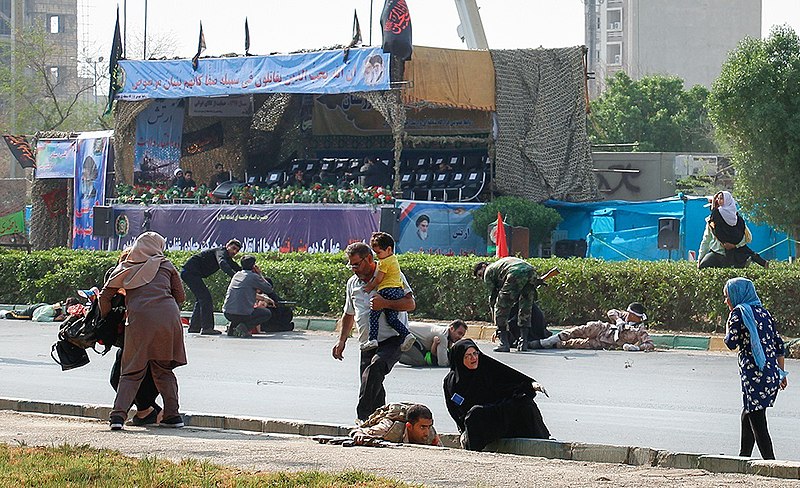
The Iranian government was quick to blame the 22 September attack targeting an Iranian Revolutionary Guard parade on the US and unnamed countries in the region. While this attribution fits with the paranoid world view of Iran’s leadership, there is potentially a degree of truth to its claims, given the current proxy war between Iran and the US and its Middle Eastern allies, and the US history of support for separatist minority groups in Iran.
Two groups have claimed responsibility for the attack: Ahwazi separatists—an Arab ethnic group based in southwestern Iran—and Islamic State. Ahwazi Arabs have been
responsible for a number of attacks in Iran over several decades and they have recently tended to target critical economic infrastructure such as oil pipelines. If an Ahwazi group was, in fact, behind the attack on the Revolutionary Guard parade, then it’s the most audacious and significant operation yet undertaken by Ahwazi separatists.
Islamic State also clearly has the capabilities and intent to undertake an attack of this nature. But the group’s
only previous attack on Iranian soil was in 2017, when four of its fighters launched simultaneous attacks against the Iranian Parliament and the mausoleum of Ayatollah Khomeini in Tehran. And while IS has a history of falsely claiming credit for terrorist attacks, Ahwazi separatists do not, and therefore it is more likely that the latter group was responsible for this attack. The release of a video on 25 September by IS
purporting to show the attackers muddies the waters slightly, but it is curious that the attackers do not declare membership of or support for IS, and this video is still not clear proof of IS involvement.
The Ahwazi Arabs are just one of a number of ethnic minorities in Iran that have spawned either nationalist separatist groups—which include the Ahwazi Arabs, Kurds and Azeris—or militant fundamentalist Sunni groups such as the Baluchis of eastern Iran. The main militant Baluchi group, Jundullah, has been linked to Al Qaeda.
There are also Persian groups-in-exile that are committed to the overthrow of the Iranian regime and have undertaken armed attacks in Iran and against Iranian interests, the most prominent of which is the
Mujahedeen-e-Khalq (MEK). MEK has been
linked to a number of high profile attacks in Iran, including the murder of Iranian nuclear scientists
orchestrated by Israel.
Separatist groups such as these have long featured on the radar of US policy makers as potential proxies in its cold war against Iran. Ahwazi Arabs are particularly attractive as candidates to act as US proxies, because their home in Khuzestan province
produces 80% of Iran’s crude oil revenue. By fomenting instability in this region, the US could dramatically impact Iran’s overall economic situation. In 2008, when tensions surrounding the Iranian nuclear program were approaching their peak,
claims emerged that the George W. Bush administration had obtained Congressional approval for several hundred million dollars in funding for covert operations in Iran that included support for Ahwazi and Baluchi separatist groups. As
noted by the source of the claims, Seymour Hersh, ‘the strategic thinking behind this covert operation is to provoke enough trouble and chaos so that the Iranian government makes the mistake of taking aggressive action which will give the impression of a country in acute turmoil. Then you have what the White House calls the ‘casus belli’, a reason to attack the country’.
While it’s likely that US covert operations supporting these groups were suspended under Barack Obama following the signing of the Iran nuclear agreement, it’s equally possible that Donald Trump has dusted off Bush’s playbook and has resumed covert support for these groups.
A number of key Trump administration officials are on the record supporting Iranian opposition groups as a means for realising change in Iran. Prior to being appointed as National Security Advisor, John Bolton
spoke at a rally in a Paris organised by MEK, which was only delisted as a terrorist organisation in 2012. During the rally, Bolton said ‘the outcome of the president’s policy review should be to determine that Ayatollah Khomeini’s 1979 revolution will not last until its 40th birthday…the declared policy of the United States should be the overthrow of the mullahs’ regime in Tehran’.
Secretary of State Mike Pompeo has been equally hawkish in his stance on Iran. Although Pompeo maintains that he is seeking to change the Iranian regime’s behaviour, not change Iran’s regime, the demands that he has levied on Iran since becoming secretary of state have been
characterised as designed to either break the regime or push it towards a resumption of its nuclear program, thus giving the United States and Israel an excuse for military action.
In view of the above, Iran’s leadership could be excused for thinking that the US or one of its allies was behind the recent attack in Ahwaz. Not only does the US have a history of supporting groups such as the one that claimed credit for the attack, but the renewed use of proxy groups to destabilise the Iranian government would also be consistent with the apparent objectives of the Trump administration. The US and Iran are already engaged in a proxy war in Syria, and only the day before the Ahwaz attack,
Pompeo threatened Iran with retaliation following a rocket attack against US bases in Iraq by Iranian proxies.
Despite the economic hardships facing Iran and growing dissatisfaction with the government, it’s likely that the Iranian theocracy, backstopped by the Revolutionary Guard, will prove remarkably resilient. At a minimum, any covert US programs will merely harden the resolve of Iran’s leaders and embolden them to strike back at US interests via their own proxies. But should the US strategy succeed in undermining the Islamic Republic of Iran, then the chaos that would follow would likely not only tear apart Iran itself, but also draw all of its neighbours into conflict.
 Print This Post
Print This Post